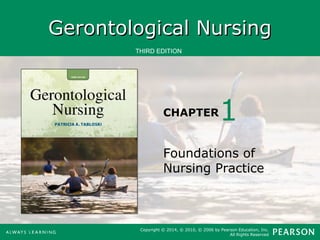
Tabloski ch01 lecture
- 1. GGeerroonnttoollooggiiccaall NNuurrssiinngg THIRD EDITION CHAPTER 1 Foundations of Nursing Practice Copyright © 2014, © 2010, © 2006 by Pearson Education, Inc. All Rights Reserved
- 2. Learning Objectives 1. Interpret demographic data according to race, gender, and age. 2. Relate leading causes of morbidity and mortality among older adults. 3. Identify common myths of aging and their contribution to ageism. 4. Describe the effects of chronic disease. Gerontological Nursing, Third Edition Patricia A. Tabloski
- 3. Learning Objectives 5. Contrast several major theories of aging. 6. Evaluate the natural history of disease using principles of epidemiology. Gerontological Nursing, Third Edition Patricia A. Tabloski
- 4. Box 1-2 Benefits of Healthy Aging Gerontological Nursing, Third Edition Patricia A. Tabloski
- 5. Demographics and Aging • The proportion of persons over the age of 60 is projected to double worldwide over the next 50 years. Gerontological Nursing, Third Edition Patricia A. Tabloski
- 6. Aging trends will affect older people in different ways. • Over the next 20 years 74 million baby boomers will retire. Medicare and Social Security will add 10,000 new retirees per day. • The old-old are the fastest growing segment of the population, growing at twice the rate of those 65 and over and 4 times faster than the total U.S. population. This group will triple by 2050. Gerontological Nursing, Third Edition Patricia A. Tabloski
- 7. Figure 1-2 Population by age and sex: 2000 and 2010. Source: U.S. Census Bureau, 2010. Gerontological Nursing, Third Edition Patricia A. Tabloski
- 8. Longevity and the Sex Differential • Women now comprise the majority of the older population. • In the United States the ratio of men to women over the age of 65 is 49 men to every 100 women. • Older women face different socio-economic circumstances. • The differences between countries have narrowed over time. Gerontological Nursing, Third Edition Patricia A. Tabloski
- 9. Life After 65 • Health care has improved. • There has been an increase in the use of preventive services. • People are choosing healthier lifestyles. • Medicare has expanded coverage of preventive services. • The older adult should be urged to assume more responsibility for healthy aging. Gerontological Nursing, Third Edition Patricia A. Tabloski
- 10. Living Longer or Living Better • The death rate for 7 of the 10 leading causes of death has decreased. • The death rate increased for Alzheimer’s disease, nephritis, nephrotic syndrome, and nephrosis. • Heart disease, cancer, stroke, chronic obstructive pulmonary disease, and diabetes account for two-thirds of all deaths each year. Gerontological Nursing, Third Edition Patricia A. Tabloski
- 11. Figure 1-5 Leading causes of death for men and women 65 years and older. Source: Centers for Disease Control and Prevention (2011); National Center for Health Statistics, data from the National Vital Statistics System (2006). Gerontological Nursing, Third Edition Patricia A. Tabloski
- 12. Box 1-4 Most Common Causes of Disability in the Gerontological Nursing, Third Edition Patricia A. Tabloski United States Source: Centers for Disease Control and Prevention (2011).
- 13. Healthy People 2020 • “Healthy People 2020” is the prevention agenda for the United States: – Establish quality measures; identifying levels of training for people who care for older adults. –Achieve health equity, eliminate disparities, and improve the health of all groups. Gerontological Nursing, Third Edition Patricia A. Tabloski
- 14. Theories of Aging • The study of aging continues to grow and evolve. • Normal aging includes: –Changes in the heart, arteries, lungs, brain, kidneys, bladder, body fat, muscles, bones, sight, hearing, and personality. Gerontological Nursing, Third Edition Patricia A. Tabloski
- 15. Figure 1-8 Normal changes of aging. Gerontological Nursing, Third Edition Patricia A. Tabloski
- 16. Theories of Aging • The study of aging continues to grow and evolve. • Each body system is affected by aging. • Modifiable changes can be slowed by healthy lifestyle. Gerontological Nursing, Third Edition Patricia A. Tabloski
- 17. Major Theories of Aging • Biological • Psychological • Sociological Gerontological Nursing, Third Edition Patricia A. Tabloski
- 18. Biological Aging Theories • Programmed Theories –Aging follows a biological timetable • Error Theories – Emphasizes environmental assaults to the human system Gerontological Nursing, Third Edition Patricia A. Tabloski
- 19. Psychological Aging Theories • Jung’s Theory of Individualism –As a person ages, the shift of focus goes from extroversion to introversion. • Erikson’s Developmental Theory – Eight stages of life – the older adult, integrity versus despair. Gerontological Nursing, Third Edition Patricia A. Tabloski
- 20. Sociological Aging Theories • Disengagement Theory – The older person and society engage in a mutual and reciprocal withdrawal. • Activity Theory –Older adults stay active and engaged to enjoy old age. • Continuity Theory –Aging involves maintaining previous values and habits. Gerontological Nursing, Third Edition Patricia A. Tabloski